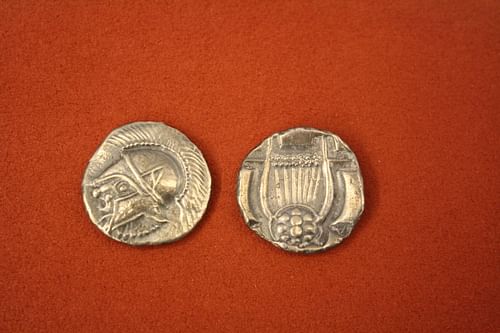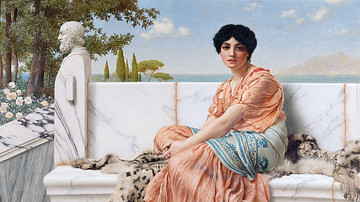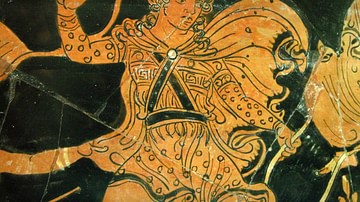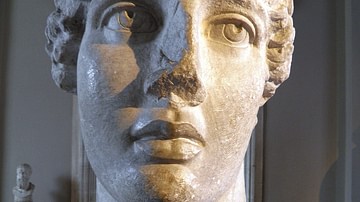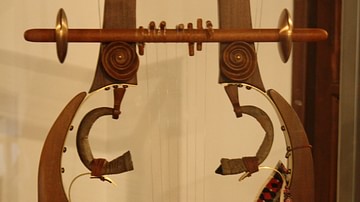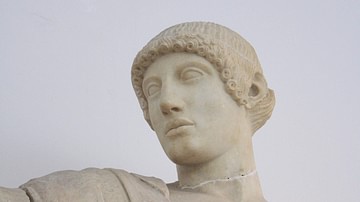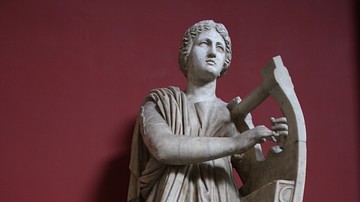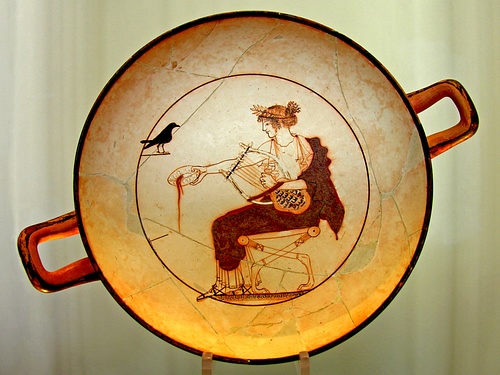
The Lyre was a stringed musical instrument played by the ancient Greeks. It was probably the most important and well-known instrument in the Greek world. The lyre was closely related to the other stringed instruments: the chelys which was made from a tortoise shell, the four-stringed phorminx, and the seven-stringed kithara. Apollo and Orpheus were the most famous lyre players.
Greek Lyres in Mythology
In Greek mythology, all four instruments are often named interchangeably in various myths, and Hermes is generally credited with their invention. The messenger god made the instrument from a tortoise shell, gut, and reeds, principally to help him steal 50 prize cattle from Apollo's sacred herd. Apollo discovered the theft and was only placated by Hermes' offer of the lyre. Apollo, from that point on, was considered the player par excellence of the lyre. Apollo also taught that other great mythical musician, Orpheus, how to play the instrument which would become his emblem. Orpheus was believed to be Thracian, which helped reinforce the belief that the lyre had its origins there. However, the invention of the seven-string version of the lyre is credited to Terpander of Lesbos. Other mythical figures often seen with a lyre include Eros and the Muses.
How Were Lyres Made?
The stringed instrument usually had two fixed upright arms (pecheis) or horns (kerata) and a crossbar (zygos) with tuning pegs (kollopes) of bronze, wood, ivory, or bone. Seven strings (neurai or chordai) of equal length but varying thickness (usually made from sheep gut) stretched between the crossbar and a fixed tailpiece (chordotonon) and were played by strumming or plucking by hand, usually using a plectrum made of wood, ivory, or metal. Played sitting or standing, the instrument was held in the hand and sometimes supported with a carrying strap worn over the shoulder of the player. The majority of musicians who played the lyre were male, but some depictions in art, most notably the clay dancers from Minoan Palaikastro (1420-1300 BCE), do show a female lyre player. Certainly, musicians enjoyed special status as their distinctive costume of a long gown in Greek art shows. In addition, Minoan hieroglyphs had a unique symbol for musicians, and a Linear B tablet from Thebes (1250-1200 BCE) mentions lyre players as members of the Mycenaean palace staff.
The lyre was played either alone or as an accompaniment to singing or lyric poetry at all manner of occasions such as official banquets, symposia (private drinking parties), religious ceremonies, funerals, and in musical competitions such as those held at the great Panathanaia, Pythia, and Karneia festivals.
Lyres in Greek Art
Greek lyres are frequently depicted in all forms of Greek art and the earliest examples date from the middle Bronze Age (c. 2000 BCE) in the Cycladic and Minoan civilizations. At Akrotiri on Thera, a fresco shows a small triangular lyre played by a blue monkey. At Knossos on Crete a small alabaster lyre is decorated with a swan's head on each arm of the instrument. Slightly later, across the Aegean in the 14th century BCE, lyres develop S-shaped arms and are frequently decorated with water-birds. Lyres were also used as decorative motifs on late Minoan pottery. A sarcophagus from Hagia Triada depicts a seven-string lyre, a wall-painting from Mycenaean Pylos has a five-string lyre and a krater from Tiryns depicts a three-string version. Decorated ivory fragments of lyres survive from Mycenae. Lyres frequently appear on later Greek pottery - geometric, red- and black-figure pottery - from the 8th century BCE. Interestingly, all lyre players depicted in Greek art are right-handed.
A tortoise sound-box from the 5th century BCE survives, as do tuning pegs from the 6th century BCE. Several carved figures from the arms of lyres have survived, notably an inlaid ivory youth from Samos (c. 7th century BCE) and a woman with sphinx and swan from c. 600 BCE. Complete lyres survive from the Hellenistic period, a notable example being the bronze lyre from the Antikythera shipwreck.
The Importance of Lyres in Greek Culture
Music, and specifically playing the lyre, was an integral part of Greek education. Even mythical figures enjoyed the benefits of a musical education; for example, Achilles was taught to play the lyre by the wise centaur Cheiron. Plato considered only the lyre or kithara as suitable instruments for musical education.
Several Greek city-states (poleis) also used a representation of the lyre on their coins. For example, the silver stater of Calymna in Caria (600-550 BCE) had a tortoise shell lyre on its reverse side. Unsurprisingly, considering its association with Apollo, the silver drachma of Delos had a lyre on its reverse in the 6th century BCE. Coins of Kos from the 2nd to 1st century BCE carried the head of Apollo on the obverse and a five-stringed lyre on the reverse. In the same period, coins of Thespiai - where there was a temple dedicated to Apollo and another to the Muses - carried a three-stringed lyre on their reverse sides.
